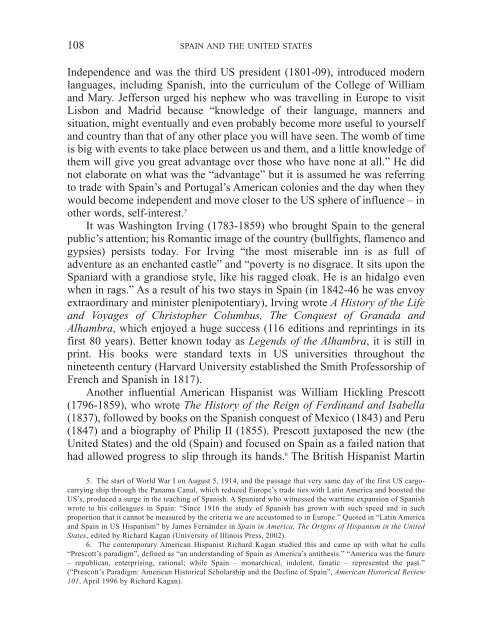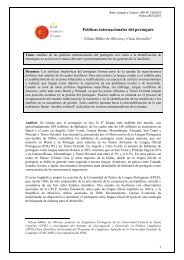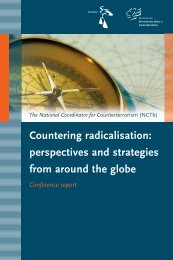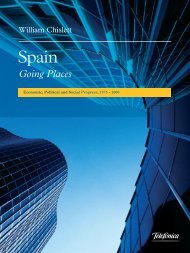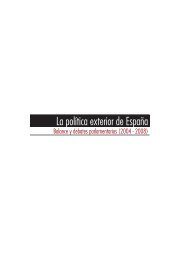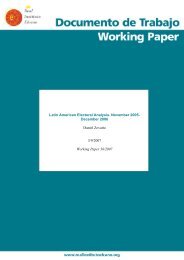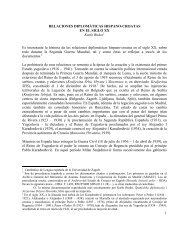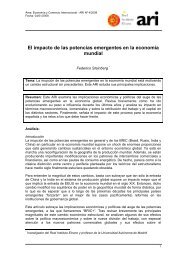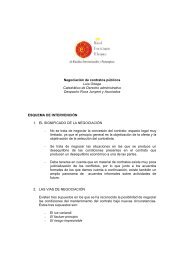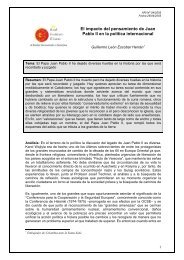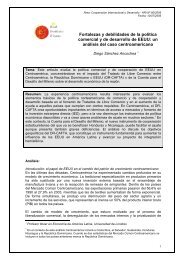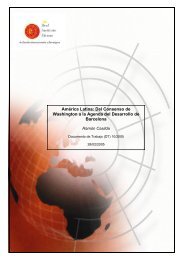Spain and the United States - Real Instituto Elcano
Spain and the United States - Real Instituto Elcano
Spain and the United States - Real Instituto Elcano
Create successful ePaper yourself
Turn your PDF publications into a flip-book with our unique Google optimized e-Paper software.
108<br />
SPAIN AND THE UNITED STATES<br />
Independence <strong>and</strong> was <strong>the</strong> third US president (1801-09), introduced modern<br />
languages, including Spanish, into <strong>the</strong> curriculum of <strong>the</strong> College of William<br />
<strong>and</strong> Mary. Jefferson urged his nephew who was travelling in Europe to visit<br />
Lisbon <strong>and</strong> Madrid because “knowledge of <strong>the</strong>ir language, manners <strong>and</strong><br />
situation, might eventually <strong>and</strong> even probably become more useful to yourself<br />
<strong>and</strong> country than that of any o<strong>the</strong>r place you will have seen. The womb of time<br />
is big with events to take place between us <strong>and</strong> <strong>the</strong>m, <strong>and</strong> a little knowledge of<br />
<strong>the</strong>m will give you great advantage over those who have none at all.” He did<br />
not elaborate on what was <strong>the</strong> “advantage” but it is assumed he was referring<br />
to trade with <strong>Spain</strong>’s <strong>and</strong> Portugal’s American colonies <strong>and</strong> <strong>the</strong> day when <strong>the</strong>y<br />
would become independent <strong>and</strong> move closer to <strong>the</strong> US sphere of influence – in<br />
o<strong>the</strong>r words, self-interest. 5<br />
It was Washington Irving (1783-1859) who brought <strong>Spain</strong> to <strong>the</strong> general<br />
public’s attention; his Romantic image of <strong>the</strong> country (bullfights, flamenco <strong>and</strong><br />
gypsies) persists today. For Irving “<strong>the</strong> most miserable inn is as full of<br />
adventure as an enchanted castle” <strong>and</strong> “poverty is no disgrace. It sits upon <strong>the</strong><br />
Spaniard with a gr<strong>and</strong>iose style, like his ragged cloak. He is an hidalgo even<br />
when in rags.” As a result of his two stays in <strong>Spain</strong> (in 1842-46 he was envoy<br />
extraordinary <strong>and</strong> minister plenipotentiary), Irving wrote A History of <strong>the</strong> Life<br />
<strong>and</strong> Voyages of Christopher Columbus, The Conquest of Granada <strong>and</strong><br />
Alhambra, which enjoyed a huge success (116 editions <strong>and</strong> reprintings in its<br />
first 80 years). Better known today as Legends of <strong>the</strong> Alhambra, it is still in<br />
print. His books were st<strong>and</strong>ard texts in US universities throughout <strong>the</strong><br />
nineteenth century (Harvard University established <strong>the</strong> Smith Professorship of<br />
French <strong>and</strong> Spanish in 1817).<br />
Ano<strong>the</strong>r influential American Hispanist was William Hickling Prescott<br />
(1796-1859), who wrote The History of <strong>the</strong> Reign of Ferdin<strong>and</strong> <strong>and</strong> Isabella<br />
(1837), followed by books on <strong>the</strong> Spanish conquest of Mexico (1843) <strong>and</strong> Peru<br />
(1847) <strong>and</strong> a biography of Philip II (1855). Prescott juxtaposed <strong>the</strong> new (<strong>the</strong><br />
<strong>United</strong> <strong>States</strong>) <strong>and</strong> <strong>the</strong> old (<strong>Spain</strong>) <strong>and</strong> focused on <strong>Spain</strong> as a failed nation that<br />
had allowed progress to slip through its h<strong>and</strong>s. 6 The British Hispanist Martin<br />
5. The start of World War I on August 5, 1914, <strong>and</strong> <strong>the</strong> passage that very same day of <strong>the</strong> first US cargocarrying<br />
ship through <strong>the</strong> Panama Canal, which reduced Europe’s trade ties with Latin America <strong>and</strong> boosted <strong>the</strong><br />
US’s, produced a surge in <strong>the</strong> teaching of Spanish. A Spaniard who witnessed <strong>the</strong> wartime expansion of Spanish<br />
wrote to his colleagues in <strong>Spain</strong>: “Since 1916 <strong>the</strong> study of Spanish has grown with such speed <strong>and</strong> in such<br />
proportion that it cannot be measured by <strong>the</strong> criteria we are accustomed to in Europe.” Quoted in “Latin America<br />
<strong>and</strong> <strong>Spain</strong> in US Hispanism” by James Fernández in <strong>Spain</strong> in America, The Origins of Hispanism in <strong>the</strong> <strong>United</strong><br />
<strong>States</strong>, edited by Richard Kagan (University of Illinois Press, 2002).<br />
6. The contemporary American Hispanist Richard Kagan studied this <strong>and</strong> came up with what he calls<br />
“Prescott’s paradigm”, defined as “an underst<strong>and</strong>ing of <strong>Spain</strong> as America’s anti<strong>the</strong>sis.” “America was <strong>the</strong> future<br />
– republican, enterprising, rational; while <strong>Spain</strong> – monarchical, indolent, fanatic – represented <strong>the</strong> past.”<br />
(“Prescott’s Paradigm: American Historical Scholarship <strong>and</strong> <strong>the</strong> Decline of <strong>Spain</strong>”, American Historical Review<br />
101, April 1996 by Richard Kagan).


